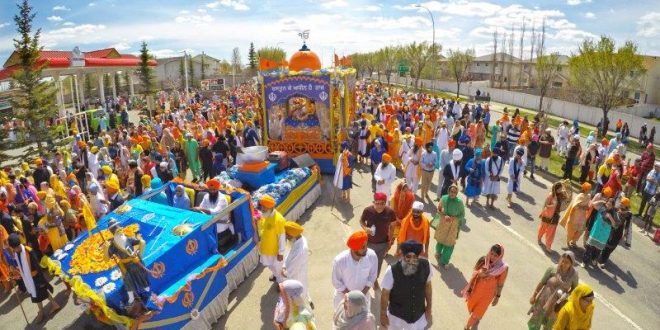By Sharanjit Kaur Sandhra
To honour the incredible work that Sikh men and women have done before us, let us not forget their struggles, their stories and their names
Vaisakhi is a time for rejuvenation, reflection and contemplation. As a Sikh woman, I revel in my Sikh history as it connects to each of these three themes. I revel because I know that it was on this day our 10th living Guru, Gobind Singh Ji founded the Khalsa Panth, those who are pure in mind, body and spirit. I am an advocate for history and heritage. We all need to know our collective histories and stories because these connect to who we are and where we come from. These histories are a connecting thread and can be brought forward into a not-so distant history as well-through the history of the Sikh community in British Columbia.
Historically speaking, Sikhs have always had a penchant for courageous travel, movement and adventure. It is no wonder that from protecting our faith (and others’ faiths) from Mughal invaders throughout our history, to our service in the Great World Wars of, etc., we were unafraid to venture the treacherous seas in order to travel and build new lives in British Columbia. The first Sikhs in fact to see these lands located on Indigenous territory since time immemorial, were Sikh soldiers who were a part of the Hong Kong regiment of the British Indian Army in 1897.
These soldiers saw the land from afar, and they fell in love with it. They knew this setting was for them, and they could build their lives with their families in this province and country. Of course, 20th century British Columbia and Canada was not the most welcome of spaces at this time.
There was much racism against indigenous peoples, Chinese settlers, Japanese settlers and many others who did not fit a norm of European whiteness. Sikh men in particular, because of their appearance, especially those who wore their outward symbols of faith, including the turban, were often met with violence on many fronts. Despite the racism, the lack of access to qualifying jobs or accommodations and so many more struggles, these men (there was a large population of men due to restrictive government measures not allowing families to join the men) forged on with strength and courage to be successful within the sawmill industry in particular, build their own companies, find their own paths of independence and surpass the hindrances placed upon them.
The incredible resiliency and determination was also exhibited by the small population of Sikh women in Province during the early 20th century as well. Women carried the extra burden and weight to preserve the core identity of the family and to persevere forward and raise children who maintained their determination in the face of so much racism. These women do not often get the credit deserved; however, if it wasn’t for them, the community would not have had the strength to withstand the struggles they faced. When legislation restrictions were reverted in the 1920’s, families were reunited and a sense of community building began to take place. Here as well, was a time of rejuvenation and growth for the Sikh community in BC.
Over the last century and more since Sikhs have been in this Province and country, they have excelled and prospered; however, it is critically important that reflect back on the struggles through which they prospered. And to understand that as Sikhs, this is intrinsic to our ethos as a people, because the history of struggle, resiliency and triumph goes back from the time of our gurus. Each of the articles of the Khalsa faith are symbolic of those struggles and triumphs, and during this celebratory time of Vaisakhi, we should not lost sight of those histories. Those histories are embedded in our skin.
As we take part in the nagar kirtan’s across the lower mainland and see the sea of faces amidst reams of bright colours, dastaar and suits, let us take a mindful moment to reflect back on our community histories, the histories of our faith, and why we take part in these nagarkirtan’s. It is important that we teach our children, and our grandchildren, our nieces and our nephews these stories and histories so they grow up with a confidence in who they are and can impart that on those who may not know. This month, the month of April, has been designated as Sikh Heritage Month across Canada. To honour the incredible work that Sikh men and women have done before us, let us not forget their struggles, their stories and their names.
Here are two stories of Amazing people who are invaluable part of Sikh Canadian history
GURBAKSH SINGH DHALIWAL
Gurbaksh Singh was born in 1934 in the village of Chananwal, district Sangrur, Punjab. He arrived in Mission, BC on October 27, 1948 and was accompanied by his mother, Gurdev Kaur Dhaliwal and uncle, Balwant Singh Dhaliwal. The family came to join his father Hari Singh Dhaliwal, who by then had a well-established trucking business in Mission called “Paul Brothers Wood and Saw Dust.”
Upon arrival, Gurbaksh Singh was enrolled in the seventh grade at Mission High. He had to drop out after grade 11 due to his father’s health problems.
In 1948, Mission was a very diverse community with many immigrant groups settled there. Gurbaksh Singh’s family owned eight lots of property on Horne Avenue (25ft/lot), which included their house and five shops. These shops were rented out to several other immigrant settlers such as French, Polish and Czech people to establish businesses. The shops consisted of a repair shop, restaurant, office, store for selling and repairing power saws and a store for sharpening them. In 1968, the property was sold to the city of Mission for the construction of the Mission bridge.
Later, he worked and became a shareholder and a Board of Director with the “Canadian Plywood Company” in New Westminster. In 1968, the family moved out to Surrey.
The “Canadian Plywood Company” later closed down and Gurbaksh Singh started to work for the “Acorn Forest Industry.” Then in 1989, he was offered a pension plan to retire since the company was closing down. After retiring, he worked in a security company for eight years, and officially retired in 1999.
Gurbaksh Singh explains that in 1948, the population of Punjabi’s in Canada was very small. There were four bachelors in Toronto and two families in Calgary (the Harry and Rama family). There were approximately four or five families in Kamloops, three in Chilliwack, one in Agassiz, two to three in Abbotsford, four to five in Mission and the rest of the population was in New Westminster, Vancouver, and Vancouver Island. At that time, the total population throughout Canada was 1800 Punjabi’s, according to Gurbaksh Singh.
INDAR SINGH GILL
A Pioneer and an Entrepreneur.
Indar Singh Gill came to Canada in 1930 at the age of 17, leaving behind a wife and an 8 month old daughter in the care of his parents. The economic hardships faced in India due to poor cultivation and lack of irrigation made many seek a better life in Singapore, Malaya, or East Africa. It was Indar’s Taiyaji Niranjan Singh Gill, already settled in Canada, who gave Indar the ticket to a better future.
Due to the depression, all sawmills had shut down, thus eliminating all employment possibilities. Indar had the desire to work so sought out any jobs which were available. He found the opportunity to work for Sher Singh Ahluwalia in Kamloops, picking tomatoes and harvesting potatoes for three months.
In 1951, Indar started his own business under the name of Indar Fuel Company, where he delivered wood and sawdust to people to burn in their homes for heat. He had a number of trucks which he used to pick up raw material from Albert McMahon’s mill in the east side of Mission at Suicide Creek. In 1958, the appearance of natural gas brought the end of his company so in 1959 he purchased an old sawmill in Mission on the Fraser River. This mill was destroyed near the end of 1959 due to fire, so in 1960 construction of the new modern Fraser Valley Sawmill started. This mill employed 30-40 workers who helped produce 60,000 board feet of lumber per shift, to be exported to the United States, Japan, and the Great Britain. The sawmill was never rebuilt after the fire on October 9th 1964. Then in 1979, Indar built a shake and shingle mill in Fort Langley called Langley Forest Industries Ltd., which still operates to the present day. In the 1980’s, he became involved in raspberry production and land development, after serving as President of the old Sikh temple in Abbotsford in 1951 again in 1979.
Indar Singh Gill had the determination and courage to go from a sawmill worker to owner during his stay in Canada. He was a man whose first priority was his family. Nash says, “He wanted to raise his kids, he wanted his kids to have good education, and he wanted them to have an easier life than he did, he wanted them to live nicely, and he would forego a lot of his own luxuries for the sake of his family”.
Credit: South Asian Studies Institute
 Sharanjit Kaur Sandhra is Coordinator,
Sharanjit Kaur Sandhra is Coordinator,
South Asian Studies Institute,
University of the Fraser Valley
 Desi Today Magazine
Desi Today Magazine




